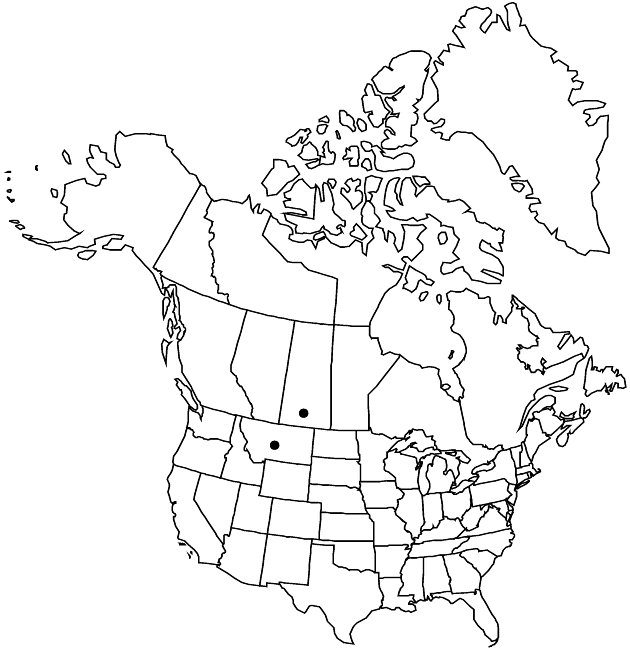Difference between revisions of "Senecio integerrimus var. scribneri"
Leafl. W. Bot. 9: 109. 1960.
EndemicConservation concern
Basionym: Senecio scribneri Rydberg Mem. New York Bot. Gard. 1: 441. 1900
FNA>Volume Importer |
imported>Volume Importer |
||
| (3 intermediate revisions by 2 users not shown) | |||
| Line 6: | Line 6: | ||
|place=9: 109. 1960 | |place=9: 109. 1960 | ||
|year=1960 | |year=1960 | ||
| + | }} | ||
| + | |special_status={{Treatment/ID/Special_status | ||
| + | |code=E | ||
| + | |label=Endemic | ||
| + | }}{{Treatment/ID/Special_status | ||
| + | |code=C | ||
| + | |label=Conservation concern | ||
}} | }} | ||
|basionyms={{Treatment/ID/Basionym | |basionyms={{Treatment/ID/Basionym | ||
|name=Senecio scribneri | |name=Senecio scribneri | ||
|authority=Rydberg | |authority=Rydberg | ||
| + | |rank=species | ||
|publication_title=Mem. New York Bot. Gard. | |publication_title=Mem. New York Bot. Gard. | ||
|publication_place=1: 441. 1900 | |publication_place=1: 441. 1900 | ||
| Line 29: | Line 37: | ||
|distribution=Sask.;Mont. | |distribution=Sask.;Mont. | ||
|discussion=<p>Of conservation concern.</p><!-- | |discussion=<p>Of conservation concern.</p><!-- | ||
| − | --><p>Variety scribneri is poorly known and seldom collected. It is distinguished by its relatively larger heads and narrower leaves and its indument (in a region where < | + | --><p>Variety scribneri is poorly known and seldom collected. It is distinguished by its relatively larger heads and narrower leaves and its indument (in a region where <i></i>var.<i> integerrimus</i> is notably glabrate).</p> |
|tables= | |tables= | ||
|references= | |references= | ||
| Line 38: | Line 46: | ||
-->{{#Taxon: | -->{{#Taxon: | ||
name=Senecio integerrimus var. scribneri | name=Senecio integerrimus var. scribneri | ||
| − | |||
|authority=(Rydberg) T. M. Barkley | |authority=(Rydberg) T. M. Barkley | ||
|rank=variety | |rank=variety | ||
| Line 52: | Line 59: | ||
|publication title=Leafl. W. Bot. | |publication title=Leafl. W. Bot. | ||
|publication year=1960 | |publication year=1960 | ||
| − | |special status= | + | |special status=Endemic;Conservation concern |
| − | |source xml=https:// | + | |source xml=https://bitbucket.org/aafc-mbb/fna-data-curation/src/2e0870ddd59836b60bcf96646a41e87ea5a5943a/coarse_grained_fna_xml/V19-20-21/V20_1233.xml |
|tribe=Asteraceae tribe Senecioneae | |tribe=Asteraceae tribe Senecioneae | ||
|genus=Senecio | |genus=Senecio | ||
Latest revision as of 19:59, 5 November 2020
Herbage usually villous, sometimes arachnose or tomentose, at flowering. Leaves: basal and proximal cauline ± petiolate; blades (cauline) oblong or lanceolate to sublinear (6–10 × 0.5–2 cm). Heads 3–6(–16+). Phyllaries ± linear, 10–15 mm, tips usually green, rarely black. Ray florets probably mostly 5; corollas yellow, laminae 12–15 mm.
Phenology: Flowering spring.
Habitat: Plains and open foothills
Elevation: 300–1600 m
Discussion
Of conservation concern.
Variety scribneri is poorly known and seldom collected. It is distinguished by its relatively larger heads and narrower leaves and its indument (in a region where var. integerrimus is notably glabrate).
Selected References
None.
Lower Taxa
None.
